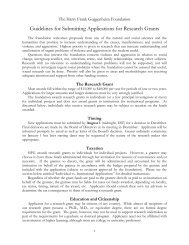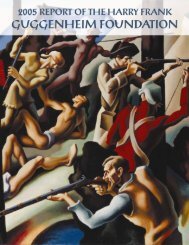Small Arms and Light Weapons - Harry Frank Guggenheim ...
Small Arms and Light Weapons - Harry Frank Guggenheim ...
Small Arms and Light Weapons - Harry Frank Guggenheim ...
- No tags were found...
Create successful ePaper yourself
Turn your PDF publications into a flip-book with our unique Google optimized e-Paper software.
level preference:In the mid-1980’s, roughly 75 years after the firstintroduction of small arms to the Nuers of easternUpper Nile, Hutchinson found a culture where display<strong>and</strong> use of weapons confirmed masculine identity <strong>and</strong>Nuer-historic identification as proud warriors. Throughthe collective ownership <strong>and</strong> presentation in the bridewealthexchange, guns contributed to a social expansionof self. <strong>Weapons</strong> ranged high in value <strong>and</strong> status, <strong>and</strong>the symbolic meaning was in line with the general ethicof the society.Through the next 15 years of civil war, small armsproliferated at an accelerating pace among the civil population.With increased access <strong>and</strong> a near-saturatedmarket, the price of guns fell, making procurement ofweapons a matter of individual capacity <strong>and</strong>, to someextent, initiative <strong>and</strong> creativity. Individualised ownershipled to the development of a sub-culture of armedyouth, undermining the positive valuation of weaponsas a symbol of collective spirit. What used to be a strongsymbol of willingness to defend families, wealth <strong>and</strong>cultural integrity became tools for antisocial behaviour<strong>and</strong> further withering of cultural values. 6In the Nuer case, growth in the supply ofweapons attendant to civil war was clearly a factorin the proliferation of individual ownership. It isjust as clear, however, that an increase in individualdesire for weapons has occurred. But the Nuer casealso shows that while individual <strong>and</strong> collectivepreferences are key factors in dem<strong>and</strong> for weapons,they are not the whole story.Dem<strong>and</strong> is also a function of real <strong>and</strong> relativeprices, which are a constraint on the realization ofpreferences. The extent to which one's preferencefor gun ownership or possession can be realized isin part a function of the price of the weapon, theprice of necessary complements (e.g., bullets,maintenance expense, time spent training, even thepsychological discomfort of carrying a gun), <strong>and</strong>the price of acceptable offensive or defensive substitutes(e.g, time devoted to community policing).The examples below illustrate that the price of gunownership is not exclusively a monetary concept.The monetary price of an AK-47 in a particularsetting may be low while its nonmonetary pricemay simultaneously be high if the cost of acquiringthe weapon includes a high probability of receivingpenalties for illegal possession (Muggah <strong>and</strong> Brauer2004).The relationships determining dem<strong>and</strong> are actuallyexpressed in the (legal or illegal) marketplace<strong>and</strong> are further conditioned by resources. Onemay have a high preference for obtaining a weapon<strong>and</strong> the price may be low, but if personal or groupresources are lacking, dem<strong>and</strong> cannot be fulfilled.Resources may be monetary but may also be nonmonetarytradable commodities (livestock, diamonds,timber, <strong>and</strong> even women), as well as organizationalcapacity, access to enabling networks(e.g., weapons brokers), <strong>and</strong> even weapons themselves(as tools for obtaining income or for stealingother weapons). For example, individual or groupaccess to alternative forms of dealing with conflict(such as community conflict h<strong>and</strong>ling traditions)may be a “resource” which can be called uponbefore “dem<strong>and</strong>ing” a weapon, whatever the inherentpreferences for weapons <strong>and</strong> however low theprice.The dem<strong>and</strong> model reveals that specific policychoices <strong>and</strong> interventions, if uninformed by anunderst<strong>and</strong>ing of all three factors, can generatecounterproductive results. Economic incentiveschemes aimed at providing alternatives to criminality<strong>and</strong> firearm use may increase the resourcespool available for the purchase of weapons, possiblydriving up dem<strong>and</strong> if preferences—for example,the “macho” symbolism of automatic weaponsin some cultural settings—are not simultaneouslyaddressed. Many buyback schemes have contributedto this type of scenario (GAO 2000).Moreover, as pointed out above, in some communitiesthe choice to acquire a weapon is not necessarilyrendered individually but influenced by aseries of collective decision-making processes.The model also suggests that policy choices maybe enriched by examining why some individuals<strong>and</strong> groups ultimately do not choose to acquiresmall arms.34




